The 11 Differences Between Heat Lamps and Heat Mats? Which Is the Best?
When reptile heat lamps and heat mats are put up against each other, which will be the winner?? A handful of keepers and breeders still think and claim that these products stand on equal footing with each other, but this couldn’t be any farther from the truth!
Overall, a heat lamp functions better and more naturally as a heat source than a heat mat in leopard gecko husbandry. Accordingly judged in terms of the following:
- Function
- Heat produced
- Temperature control
- Power rating
- Position
- Installation
- Set-up compatibility
- Safety of use
- Usage time
- Price range
- Life span
A couple of years back, people would say that “heat is simply heat – the heat source doesn’t really matter.” However, heat is actually made of infrared A, B, and C, so what should you look for in a heat source for your leopard gecko?
Heat Lamps vs Heat Pads: Which Is Better for Leopard Geckos?
Anyone can make claims but it’s another matter entirely to be able to make it believable. The same is true when reptile keepers make claims about one product being better than the other. So let’s closely examine the factors most pet parents in the reptile community consider when it comes to picking out the absolute best heat source for their leopard gecko!
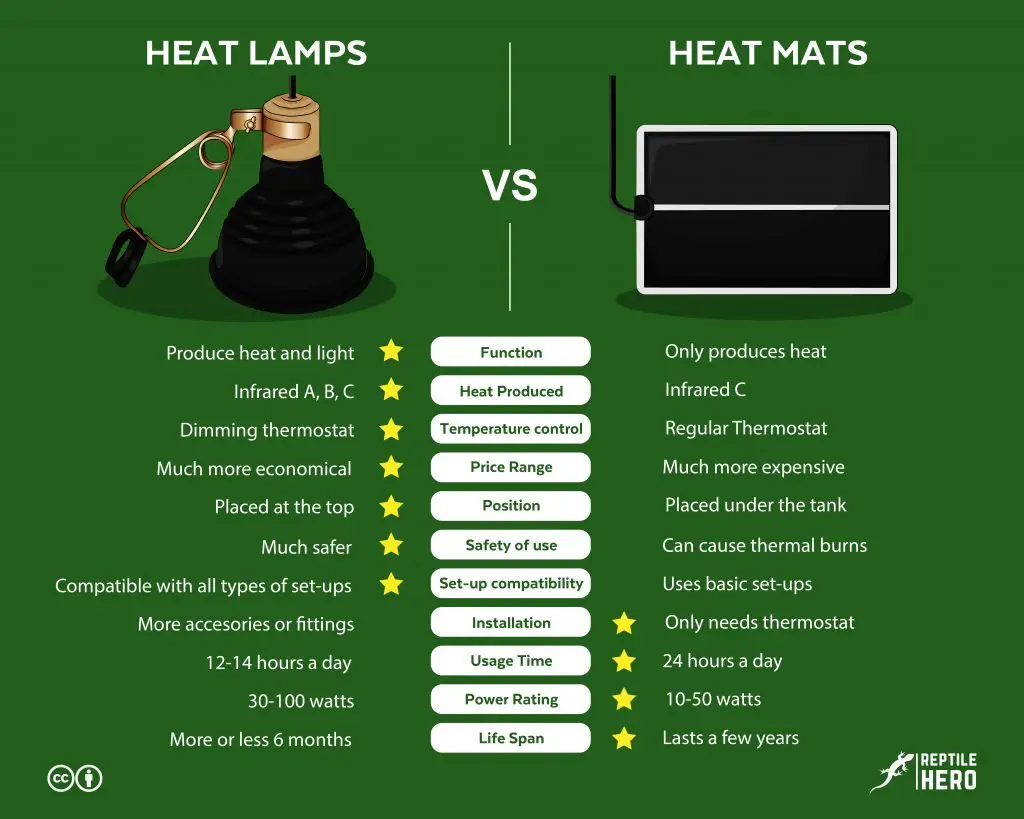
#1 – Function
Heat lamps provide both heat and light. On the other hand, heat mats only give off heat.
The sun is probably the first thing that usually comes to the minds of pet parents when we are asked to think of the best heat source we could ever give our scaly little dinos. However, doing so is easier said than done, especially since the type of weather we experience here in America is drastically different than the one their wild relatives are accustomed to in the dry and rocky grasslands of South Asia.
However, you can get a halogen heat lamp. This can make for a great substitute since it is capable of closely imitating sunlight, giving us both visible light and heat (or infrared radiation). A few models are capable of producing ultraviolet radiation as well.
Needless to say, halogen heat lamps are the perfect primary heat source we can give our leos during the day. Just make sure to turn them off after dusk so that your adorable leopard geckos don’t get their natural day-night cycles messed up.
If it can get too cold for comfort in the evenings where you are from, particularly below 65 °F (18°C), look for a supplemental heat source that does not emit visible light. If you have a minimalistic or temporary quarantine/hospital set-up, using only sheets of paper towels for the substrate, you could go for an under-the-tank heat mat.
#2 – Heat Produced
The average heat lamp normally emits thermal radiation that comprises infrared A, B, and C, which, when combined together, produces deep-penetrating heat. Conversely, reptile heat mats can only emit infrared C radiation, which is only superficial heat.
Although heat lamps and heat mats specifically manufactured for reptile-keeping are both marketed as essential heating elements, they do not actually work in the same way nor do they produce the same type of heat or infrared radiation.
| Subtype of Infrared Radiation | Wavelength (nm) | Level of Penetration |
| IR-A or near-infrared | 740-1400 | Significant |
| IR-B or mid-infrared | 1400-3000 | Moderate |
| IR-C or far-infrared | 3000-1000000 | Superficial |
Remember that leopard geckos are ectothermic crepuscular geckos which may either engage in open or cryptic basking behaviors when the sun rises early in the morning and sets later in the afternoon. Meaning, they could lay out in the open or expose only a portion of their bodies when the sun is not intensely shining up in the sky.
So although they do not bask directly under the fierce midday sun like bearded dragons, they do still get thermal radiation from the sun. To be more precise, sunlight has approximately 32% IR-A, 14% IR-B, and 2% IR-C [1]. All other inanimate objects on the earth (e.g., soil, sand, rocks, trees, etc.) which do not naturally produce heat but were exposed to sunlight then reradiates IR-C into their immediate surroundings.
In the wilderness, leopard geckos warm up while they are active during dawn and dusk with the sun and their immediate surroundings, then keep warm while they are staying within their homes – within hollow tree trunks or the crevices of rock formations.
In comparison, halogen heat lamps give off more or less 38% IR-A, 39% IR-B, and 12% IR-C but heat mats only produce 100% IR-C. Essentially, halogen heat lamps act like the sun providing significant heat for our soft-bellied babies which they can feel deeply into their cores. Conversely, heat mats are like the ground, capable of only reradiating heat that is skin-deep.

You can easily tell this massive difference by simply using your bare hands. If you place your hand a few inches under a halogen you will feel a cozy warmth. But with a mat, you would need to touch it directly to be able to tell that it is even turned on.
#3 – Temperature Control
A heat lamp must be used with a dimming thermostat or plug-in dimmer to prevent the abnormal flickering of light, the visible cue makes it easy to monitor. By contrast, a heat mat will work well with the regular on/off or pulse thermostat because it does not emit any visible light.
Since the use of halogen heat lamps as primary heat sources for leos and other herps has only started fairly recently in North America, dimming thermostats like are still hard to come by. When you do get lucky and find one, they fetch quite a high price.
Because of this, some beginner keepers have made the mistake of using on/off or mat thermostats like the one below with their halogens. Upon turning the lamp on, they quickly realize that they have made a huge mistake as the bulb keeps flashing on and off as a strobe light would.
Mat thermostats, as the name suggests, are only recommended for use along with heat mats. They work by turning on the mat until the probe on it reaches your set temperature (e.g., 90°F or 32°C). Then they cut off the power supplied to the mat until the temperature drops below your set temperature. However, it is difficult to gauge whether or not the heat mat is properly being regulated due to the lack of visual cues for operation (e.g., light).
Pulse thermostats work in a similar manner but instead of completely shutting off the heat mat, they instead control the frequency at which the electrical energy is supplied. To reach your set temperature, the pulses of energy are rapid. Once the set temperature is obtained, the pulses slow down, only to speed up again if the temperature lowers again. But these cannot be used with light-emitting heat sources like halogen heat lamp because it causes flickering as well.
The only type of thermostat appropriate for heat lamps is dimming thermostats because while they do control both the brightness and heat output of halogens, they do not cause the undesirable blinking of lights.
The dimming also isn’t erratic or bothersome, it only causes slight dimming to maintain optimal temperatures which you can set manually.
However, if you do not have the money for a good quality dimming thermostat yet, you can opt to buy a much cheaper plug-in dimmer like the one below on Amazon in the meantime. Just make sure to strictly monitor your vivarium temperatures so you can dim the lamp accordingly when needed.
#4 – Power Rating
In general, reptile-specific heat lamps have a power rating of 30 to 100 watts, whereas heat mats range from 10 to 50 watts.
Regardless of the specific type, bigger tanks typically need a heat source with higher power ratings. However, heat lamps which also function as a light source do need significantly more electrical energy to operate effectively.
| Internal Tank Capacity (gallons) | Heat Lamp Power Rating (watts) | Heat Mat Power Rating (watts) |
| 20 | 30-50 | ±10 |
| 25-50 | 50-75 | 10-25 |
| 55+ | 75-100 | 25-50 |
As you can infer from the table above, for a 50-gallon tank you would need either a 25W mat or a 75W lamp – that’s easily thrice the power consumption. But if we were to really think about this factor deeply, considering long-term usage, will your electricity costs really have a massive difference?
If you already know how to break down the amount of electricity a gecko uses, you would remember that the equation for electrical energy cost is simply:
Cost = Electrical power [x] Hours of operation [x] Electricity rate per kilowatt-hour
But remember to divide the power rating (W) by 1000 to get the kilowatt (kW) first as electricity consumption and bills are usually computed in kW.
| Device | Power (kWh) | Time (hours per day) | Rate in New York (USD) | Daily Cost (USD) | Monthly Cost (USD) | ||||
| Lamp | 0.025 | x | 12 | x | 0.214 | = | 0.0642 | x 30 = | 1.926 |
| Mat | 0.075 | x | 12 | x | 0.214 | = | 0.1926 | x 30 = | 5.778 |
Based on this computation, the difference between the costs of operating a heat lamp and a heat mat appropriate for a 50-gallon tank is not that significant, based on the average electricity rate for May 2021 in New York [2]. As a matter of fact, I would argue that running the halogen lamp is actually much more energy-efficient since it produces not only light but core-penetrating heat as well.
Then again, nowadays even regular light manufacturers have been able to produce more energy-efficient halogen bulbs without having to sacrifice in terms of light and heat output. For example, a halogen like the one shown below will only consume 70W at full power but work as efficiently as a regular 90W incandescent, if not better.
The only time the low power consumption of heat mats will come in handy is during emergencies such as a winter power outage. If you have a portable power station, using a heat mat will allow you to limit the amount of energy spent so as to provide warmth to the reptile longer.
#5 – Position
Generally, a heat lamp should be placed at the top of the vivarium, with a height of at least 12 inches (30 centimeters) from the topmost layer of the substrate. Inversely, heat mats must be placed under the tank or below a thin layer of substrate (0.39 inches or 1 centimeter). However, both should be placed on the warm side of the tank.
Since a halogen heat lamp works to imitate the sun, it should be placed overhead. Have it either attached to the ceiling in a fully enclosed enclosure, such as polyvinyl chloride (PVC) ones, or right on top of an enclosure with a wire mesh ceiling like this one from Zen Habitats.
If it gets too hot inside your leo’s fully enclosed tank (e.g., wood), should opt for one with a screened ceiling instead.
A heat mat, on the other hand, should be placed outside, right under PVC and glass vivariums, but inside wooden enclosures so that the material can’t block off the heat.
Regardless, any heating element should be positioned primarily by the vivarium’s warm side, where ambient temperatures should fall within the 85-90°F (29-32°C) range.
However, it is only possible to achieve an optimal thermal gradient and a basking spot of around 95°F (38°C) with a halogen lamp. Heat pads will provide a good, relatively even surface heat for up to 1/2 of the entire tank’s floor area, they cannot safely provide a basking zone for our precious soft-scaled friends.
#6 – Installation
More accessories or fittings are needed for the proper installation of heat lamps, whether it be internal or external. A heat mat, in comparison, only needs to be connected to the appropriate thermostat.
To install a heat lamp, you will need one or more of the following:
- Ceramic socket (here on Amazon)
- Lamp dome
- Dome clips
- Lamp holder
- Plug-in dimmer
- Clamp lamp with dimmer and switch
- Lampstand (here on Amazon)
- Plug/outlet timer
- Wire cage
- Dimming thermostat
Such a long shopping list will cost you a pretty penny up front, but you can use these things until they wear out or break down so they are great investments for most reptile pet parents. Plus, you can definitely get great package deals for them in your local exotic pet shop or reptile specialty stores online.
As you would expect, more fittings also translate to more costly, complicated, and longer overall installation.
In comparison, a thermostat is the only essential add-on product for a heat mat.
Of course, you could also pick up a heat mat holder if you can find one, but they are unbelievably hard to come by here in the US as the increasing popularity of wooden vivariums has pretty much coincided with the steady rise in demand for halogens.
More and more people are ditching the mat, so its only accessory, the holder, isn’t really needed.
#7 – Set-up Compatibility
All in all, heat lamps are compatible with all types of temporary and permanent set-ups – from basic to bioactive. Heat mats, on the contrary, are only recommendable for basic set-ups which are, by and large, just temporary.
Heat lamps are suitable for a multitude of different set-ups, be it a reasonably bare hospital set-up for sick leos, a seasonal breeding set-up complete with a lay box for little gecko eggs, or a fully decked out bioactive tank with plants, isopods, and a simple water misting system. Because the lamp is normally set on top of the enclosure, it doesn’t really affect the overall layout.
With a heat mat, however, you will need to be more careful since it should never have water accumulate on or around it. Doing otherwise may cause malfunctioning as the water gets into its terminal block. Its heat could also kill off your wooden vivarium’s clean-up crew – springtails and all – and live feeder insects. That would surely stink up not just your gecko but your entire tank.
Plus, even if you have wanted to go for a naturalistic bit, not a full-on bioactive set-up, you still can’t go for a deep substrate. As I have already mentioned earlier in the article, it doesn’t produce deep penetrating heat, so instead of the heat reaching your gecko’s skin, it may not even go past a thick substrate.
This is why most keepers and experts in the community only suggest using mats in more basic set-ups. More specifically, with temporary quarantine, travel, or emergency set-ups.
Can I use a heat lamp and a heat mat simultaneously in the same tank?
Yes, you definitely can use both a lamp and a mat all together for daytime heating. However, the heat mat should never be directly exposed under the heat of the lamp as this may cause overheating and start a fire.
#8 – Safety of Use
It is much safer to use heat lamps to help reptiles like leopard geckos obtain and maintain optimal body temperatures than with a heat mat. In fact, mats are known to have caused fatal thermal burns in reptiles.
When using a heat source there are 2 types of risks to take into account: 1) excessive dryness, 2) injury from burns and electrocution.
Dryness
Even if a leopard gecko should be housed individually in a considerably dry environment, this doesn’t mean that its tanks should be totally devoid of water. In fact, having a small water bowl or intermittent misting could save your leopard gecko from dysecdysis, or retained skin shed, which is primarily caused by dehydration and an abnormally dry environment.
You should keep this in mind when setting up your smiley little leo’s vivarium – electricity and water are not a good mix. With heat lamps, the likelihood of dangers due to water is pretty low, just make sure not to spray cool water directly onto a hot bulb to prevent it from cracking and exploding.
If you think that’s impossible, find out how badly a hot bulb – currently running on electricity – reacts with cold water:
Burns and Electrocution
Though leopard geckos are also capable of jumping, climbing, and – on an incredibly slim chance – reaching the heat lamp, it is quite unlikely for them to sustain significant burns from direct contact as they do not have sticky feet which could allow them to latch onto the lamp in theory.
For a heat mat, you also don’t have much to worry about as long as it is outside your tank, where your fiery little one can’t have direct access to it whatsoever. If you have a wooden enclosure, things are quite different since you need to install it inside.
In such instances, even if it doesn’t have exposed wires, there is still a possibility that it can malfunction because of water, especially if you have a bioactive enclosure with a misting system and/or a water feature. There’s also a likely chance that your little gecko may tip over its water bowl and drench the mat. Either way, there is a chance that your gecko could get electrocuted.
Besides that, heat mats are immensely notorious for causing severe thermal burns that have killed numerous reptiles, big and small – including leopard geckos [3]. Such injuries could easily prove life-threatening due to infections and take several months of intensive care. Even then, your leopard gecko may have to live the rest of its life with deformities or some other complication.
#9 – Usage Time
Any light-emitting heat source such as a halogen heat lamp should only be turned on for 12-14 hours a day as the primary heating source. Contrarily, a heat source like a reptile mat can virtually be on 24 hours a day as a supplemental heat source.
Similar to how long the sun stays up in the South Asian countries of Pakistan, Afghanistan, Iran, India, and Nepal, a device like a heat lamp should normally be out in the open for only about half the day [4].
To be more exact, a heat lamp should be on for 12 hours in the winter, from 6 AM to 6 PM, and 14 hours in the summer, from 5 AM to 7 PM, as your leopard gecko’s primary heating element.
If you live in an area with average daily temperatures in the 60°F (16°C) range – or even lower – all year round, you will need to run a supplemental heat source (e.g.) all day long.
When you see that even a heat mat doesn’t help boost your vivarium temperatures up to their minimum levels, consider getting another overhead heating element that doesn’t emit light so you can use it as a supplemental daytime and nighttime heat source.
#10 – Price Range
Taking only the average price per unit into consideration, heat lamps are cheaper than heat mats – with lamps generally under 10 USD per bulb and mats going over the same price point.
With a quick Google search, your will readily notice that halogens are incredibly affordable and readily available, this is why I recommend them for heat lamps over “specialty heat lamps” that are supposedly made just for reptiles.
Those types are much more expensive but don’t offer anything more than their brand and reptile-specific packaging. As a matter of fact, my friends and I have had better luck with household halogen floods working perfectly for our reptiles.
Now if we check the typical price range of reptile heat mats, they typically cost more than 10 USD. In fact, the money you would need to spend on a 35W heat mat like this one on Amazon could easily get you 5 or more halogens of the same wattage.
#11 – Life Span
On average, a heat lamp will last for more or less 6 months of continued use while a heat mat can technically last a few years.
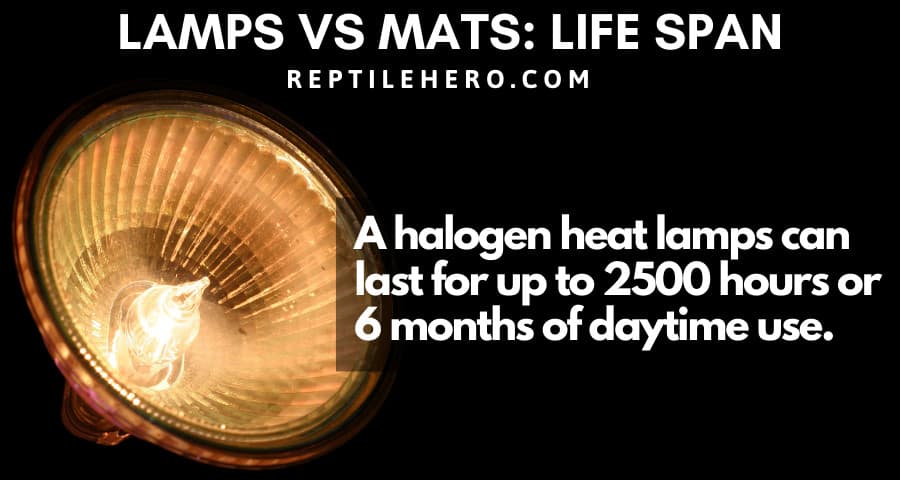
Even though gases inside the halogen bulb capsule prolong the life of the heat lamp through a process called the halogen regenerative cycle, giving it a longer life span compared to regular incandescents and other gas-filled light bulbs, it will still eventually burn out.
Typically, a halogen bulb has a life span of only up to 2500 hours [5]. Keeping in line with the standard usage time of heat lamps for leopard geckos, having your lamp on for 12-14 hours per day will give you a bulb life of about 6 months.
Alternatively, a heat mat that neither emits light nor burns out so it can virtually last you a lifetime as long as you use it with great care, as well as handle and store it mindfully.
Heat mats will continue working given that the heating element inside doesn’t get deformed or broken. So take note of durability into consideration if you are planning to get your gecko a heat mat regardless of your intended purpose for it – as an emergency or supplemental heat source.
Final Verdict on the Battle Between Heat Lamps and Heat Mats
Reptile halogen heat lamps are superior over heat mats in terms of:
- Function
- Heat produced
- Temperature control
- Position
- Set-up compatibility
- Safety of use
- Price range
However, it is still worth noting that heat mats are better in terms of:
- Power rating
- Installation
- Usage time
- Life span
If you take all factors into consideration, a good-quality heat lamp is still the preferable and healthier heat source for your leopard gecko. Sure, it does have its drawbacks, but such things are easily outweighed by all the benefits.
Takeaways
Both heat lamps and heat mats give off heat. In addition, lamps also emit visible light.
Similar to the sun, heat lamps produce IR-A, B, and C but mats can only emit IR-C, which is superficial.
Lamps and mats need a thermostat for temperature regulation – dimming and on/off or pulse respectively. However, since mats do not emit light, it is difficult to tell whether they are properly regulated.
Leopard geckos need heat lamps that have a wattage of 30 to 100 watts and/or heat mats with a wattage of only 10 to 50.
Although the two should be on the warm side, a heat lamp must be fixed at the top while the heat mat must be at the bottom.
More additional fittings are required for the installation of lamps compared to mats – whether it’s internal or external – making it more expensive, elaborate, and time-consuming.
Unlike heat lamps which are compatible with all set-ups, reptile heat mats, are only recommended for temporary basic set-ups.
Heat lamps are generally recognized as the safer heating element because heat mats could possibly cause electrocution, burns, or even death.
Reptile heating mats can continuously run, 24 hours per day, but a heat lamp should only be on for up to 14 hours a day in the summer and 12 days in the winter.
Heat lamps are cheaper per unit (less than 10 USD) than heat mats (more than 10 USD).
The average halogen heat lamp has a life span of approximately 6 months. In comparison, a heat lamp has a life span of more than 1 year.
Sources
[1] https://www.animalsathomenetwork.com/wp-content/uploads/2020/09/InfraRed-Heating-for-Reptiles.pdf
[2] https://www.bls.gov/regions/midwest/data/averageenergyprices_selectedareas_table.htm
[3] https://veterinary-practice.com/article/wound-management-in-reptiles
[4] https://www.worlddata.info/asia/
[5] https://sciencing.com/what-gas-is-found-in-light-bulbs-13412851.html

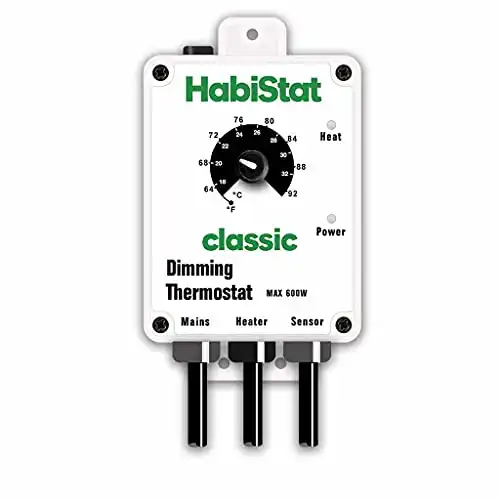
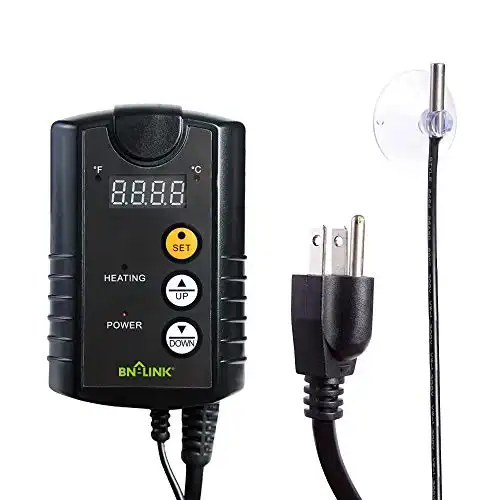
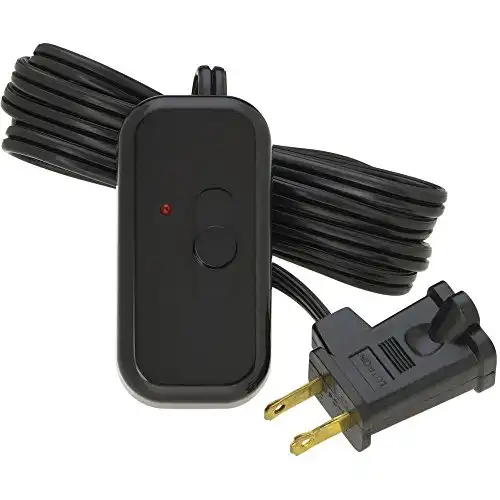
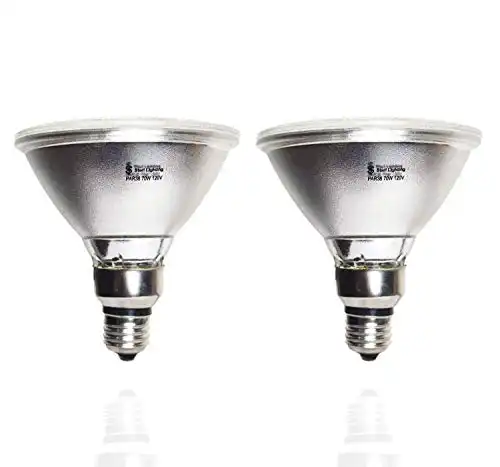
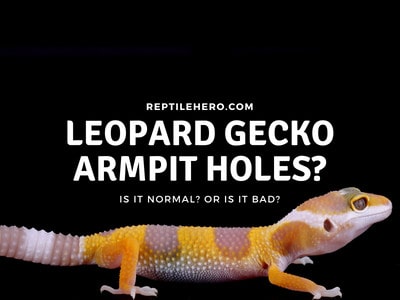
![How Do Geckos Walk on Walls? [With Science]](https://www.reptilehero.com/wp-content/uploads/2021/10/G44_-_Redesign-768x614.jpg)
![Does Your Gecko Remember You? [2 Owners’ Stories and Science]](https://www.reptilehero.com/wp-content/uploads/2021/06/Does-your-gecko-remember-you-infographic-768x614.jpg)
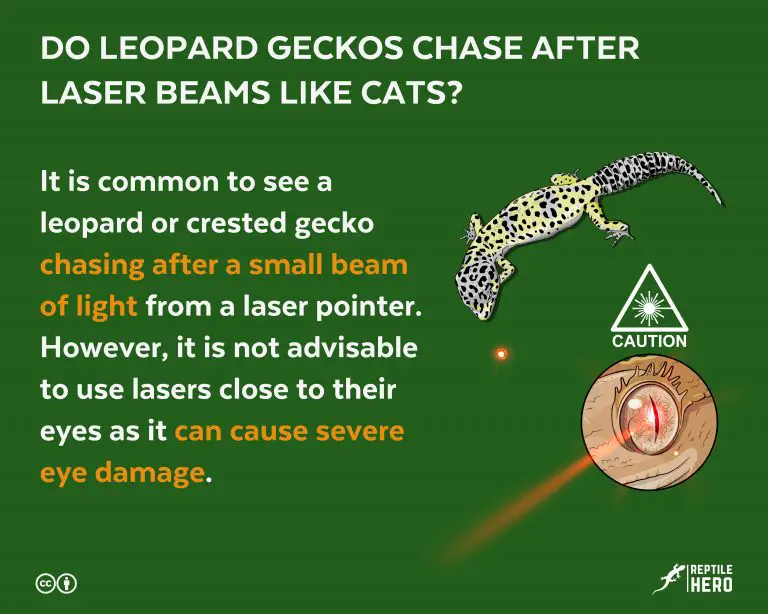
![Can Your Gecko Eat Waxworms? [3 Things You Must Know]](https://www.reptilehero.com/wp-content/uploads/2021/06/Can-gecko-eat-waxworm-infographic-768x614.jpg)
![Why is Your Leopard Gecko’s Nose Red? [9 Causes and Solutions]](https://www.reptilehero.com/wp-content/uploads/2021/10/Red-nose-gecko-cc-768x614.jpg)
